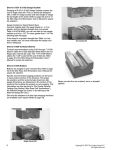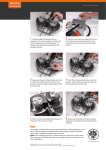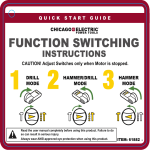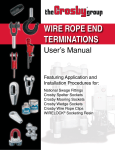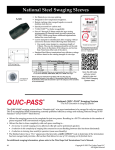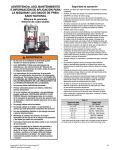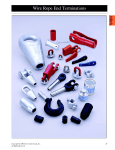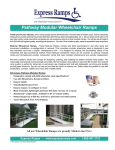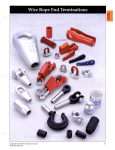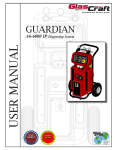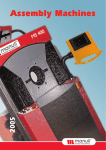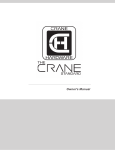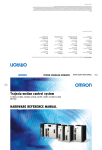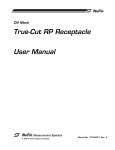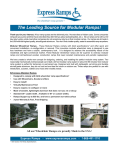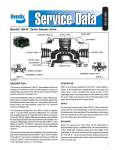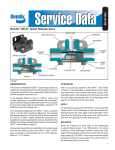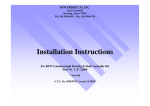Download NATIONAL SWAGING MACHINE AND DIE WARNING, USE
Transcript
NATIONAL SWAGING MACHINE AND DIE WARNING, USE, MAINTENANCE AND APPLICATION INFORMATION National Four Post Swaging Machine WARNING • Misuse of swaging machine can result in serious injury or death. • READ, UNDERSTAND, AND FOLLOW all the information in this warning document and the instructions shown in “Wire Rope End Terminations User’s Manual” before operating the swaging machine. • Swaging machine operators must be trained in accordance with the information supplied by The Crosby Group LLC. THE SWAGING MACHINE OWNER IS RESPONSIBLE FOR THE TRAINING AND THE SAFE OPERATION OF THE SWAGING MACHINE. • Do not swage oversize parts. • Only swage parts of the proper design, material and hardness. • If misused, dies and/or die holders may break. PROTECT YOURSELF AND OTHERS:Always stay away from the sides of the swaging machine during swaging operations and alert others in your work area. • Do not shim between dies. • Do not shim die or die holder unless swaging aluminum sleeves. • Do not use die holders that are damaged or have loose side rails or side plates. • Tie rod nuts must be secured to the tie rods with a secondary retention system. • Keep head, hands, and body away from moving swaging machine and die parts. • Consult die manufacturer for correct use of their product. • Adjust swaging machine tonnage to the Working Load Limit (WLL) tonnage shown on the die block being used. If the Working Load Limit is not legible, refer to Die height & width and corresponding Working Load Limit (See Table 1). Failure to do so can result in serious injury or death. Copyright © 2013 The Crosby Group LLC All Rights Reserved Operation Safety • NEVER use dies that are cracked, worn or abraded (galled). • NEVER use dies that have an oversized cavity. • ALWAYS use a matched set of dies. • When swaging steel fittings,DO NOT SHIM DIES. Dies for steel fittings must be free to float and align one to the other. • When swaging aluminum fittings, THE STEEL DIES MUST BE SHIMMED. Shim the side of the die to ensure the proper cavity alignment for flash removal. • NEVER shim between the dies. • When Swaging Crosby National fittings, use only the proper capacity swaging machine for the size of fitting used (See Swaging Capacity Chart). If the swaging machine capacity exceeds the die block Working Load Limit rating, adjust the swaging machine tonnage to the Working Load Limit shown on the die block being used. See Table 1 for die block Working Load Limit. • Always use the correct size and type of die for the size wire rope fitting used. • Make sure that the manufacturer’s die retention locking pin, bolt, or other device is engaged and has secured the die before swaging. Make sure that the dies are straight, parallel, and perpendicular to each other before and during the swaging procedure. • Always lubricate die faces and cavities with light weight oil. • Progressive swaging of fittings must be done in accordance with procedure shown in “Wire Rope End Terminations User’s Manual”. Only open channel dies are to be used. • Stop swaging when the cavity side of both dies touch. Observe the die closure from above and slightly to the side. The best position is to stand 45 degrees to either side of the front. • Make sure part is swaged to the recommended after swage dimensions (See Crosby General Catalog or “Wire Rope End Terminations User’s Manual”, Die Guide, or Die Chart). • If a swage fitting other than a Crosby National is used, determine adequacy of the termination by a destructive pull test. • All swage sockets must be swaged with socket head adjacent to the socket relief (largest radius) on the die. • For special applications or conditions, contact Crosby National (501)962-3112. TABLE 1 Die Size (Height x Width) 2” x 3-1/2” 2-1/2” x 4” 2-1/2” x 5” 4” x 7” 5” x 7” 6” x 12” Working Load Limit (WLL)* 200 Ton Mark Series 200 Ton National 500 Ton Mark Series 1,200 Ton Mark Series 1,500 Ton National 3,000 Ton National * Note: These Working Load Limits are for Crosby® National Die Blocks only. The Working Load Limits of die blocks from other manufacturers may vary. 65 Inspection Maintenance Safety • Make sure the swager is in good operating condition and that all gauges, indicators and controls are working properly. • Make sure all bolts and nuts are in place and tightened to recommended torque as shown in Table A, on page 13 for new style swaging machines, and Table B on page 14 for current swaging machines. • Load block or die base plate surfaces must be to manufacturers specifications for thickness and flatness to provide complete support of the die during swaging. • Make sure die holder side rails are not bent, loose or damaged. • Clean dies and die holder surfaces. Keep free of metal shavings, slag, grit, sand, floor dry, etc. • Lubricate the four guide bushings daily with light oil. Die Working Load Limit Pressure Adjustment on Lower Cylinder National 500 Ton through 1500 Ton Swaging Machines Follow this procedure to adjust swaging tonnage (pressure) on your swaging machine. 1. Install the die holder(s) or die adapter with the dies to be used. 2. Bring the dies together (without a part in the dies) until they just touch. 3. Turn the tonnage control valve, which is located on the control panel left of the tonnage gauge, counter-clockwise about (6) six turns or until knob no longer turns. 4. Now (without a part in the dies) apply pressure to the dies by pressing the foot pedal marked “up”. A. If the tonnage is lower than desired Working Load Limit, turn the valve clockwise while continuing to press the foot pedal marked “up” until desired Working Load Limit is reached. B. If tonnage is higher than desired Working Load Limit, release pressure by pressing the pedal marked “down”. Then repeat steps 2 through 4. 500 Ton Largest Fitting Allowed to be Swaged (in.)* Swaging Method Full Die Die Size (in.) S-505 Sleeve Mark Series 2-1/2 x 5 4x5 5x7 1-1/2 S-506 Sleeve 1-1/4* S-510 Ferrules 9/16* S-409 Buttons 7/8* 1000 Ton Full Die 4x7 5x7 2-1/2 1-1/4* 9/16* 1-1/4* 1500 Ton Full Die 5x7 6 x 12 3-1/2 1-1/4* 9/16* 1-1/4* 6 x 12 4-1/2 3000 Ton Full Die 1-1/4* 9/16* Die Working Load Limit Pressure Adjustment on 3000 Ton Swaging Machine For reducing tonnage, use selector switch on front of control panel to select lower tonnage (approximately 1500 Tons) or 3000 Ton. WARNING ALWAYS USE 5 X 7 OR 6 X 12 DIES AT 1500 TON SETTING. WARNING USE ONLY 6 X 12 DIES ON TONNAGE THAT EXCEEDS 1500 TONS. Swaging Machine Capacity Chart for S-501 and S-502 Swage Socket Swaging Machine Capacity Chart for Swage Sleeves, Ferrules and Buttons Hydraulic Swaging Machine Size • Inspect the rods for corrosion. Use #000 emery cloth or steel wool to maintain a high polish surface. • Do not increase the hydraulic system pressure above the factory preset pressure of: 6500 psi for 500 ton, 1000 ton and 1500 ton swaging machines – 5000 psi for 3000 ton swaging machine. • Under ordinary operating conditions, drain and clean reservoir every two (2) years. • Make certain that the hydraulic reservoir is full when the swager is in the full open position. • Filters inside of the reservoir should be cleaned every time the reservoir is drained and cleaned. The Racine “tell-tale” suction filter should be cleaned every six (6) months. 1-1/4* Hydraulic Swaging Machine Size Swaging Method Mark Series 2-1/2 x 5 4x7 5x7 3/4 Progressive 4x7 5x7 1-1/4 Full Shank 4x7 5x7 1 Progressive 4x7 1-1/2 Full Shank 5x7 6 x 12 1-1/4 Progressive 5x7 6 x 12 2 Full Shank 6 x 12 2 Progressive 6 x 12 2-1/2 1500 Tons * Largest size fitting available. 3000 Tons Largest Fitting Allowed to be Swaged (in.)* Full Shank 500 Tons 1000 Tons Die Size (in.) * Largest size fitting available. 66 Copyright © 2013 The Crosby Group LLC All Rights Reserved “NEW STYLE” NATIONAL HYDRAULIC SWAGING MACHINE TORQUE MAINTENANCE INFORMATION Item No. Req’d. A B C D E F G H J K L M N P Q R S T U V W X Y Z AA 1 1 1 4 8 1 2 1 4 1 1 2 2 2 2 2 1 1 4 1 4 2 2 2 1 Description Cylinder Housing Cap Piston Tie Rod Tie Rod Nut Platen Guide Gland Bushing Mono Seal Seal Spacer Side Cylinder Side Cylinder Mount Lower Bracket Knuckle Upper Bracket Check Valve Check Valve Seal Tie Rod Eyebolt Cap Eyebolt Key Bumper Bumper Strip Rubber Skirt Bottom of Seal Cavity Table B Torque in Ft-Lbs Item No. No. Req’d. 1 Varies Description Tie Rod Nut Jack-Bolts 500 Ton Swaging Machine 1000 Ton Swaging Machine 1500 Ton Swaging Machine Maintenance Schedule 105 N/A 260 Weekly 2 4 Check Valve Bolts 100 100 100 Weekly 3 8 Lower Bracket Bolts 100 100 100 Weekly 4 8 Upper Bracket Bolts 100 100 100 Weekly 5 4 Guide Bolts 250 250 250 Weekly 6 8 Bushing Screws 15 15 15 Weekly 7 4 Key Screws 4 4 4 Weekly 525 600 700 Monthly 4 4 4 Monthly 700 800 800 Monthly 8 4 Platen Bolts 9 6 Bumper Apron Screws 10 12 Gland Bolts Bolt Size Thread Form Die Holder Bolt Torque Copyright © 2013 The Crosby Group LLC All Rights Reserved Torque in ft./ lbs. 1/4 20 UNC 13 5/16 18 UNC 15 5/8 11 UNC 211 7/8 9 UNC 583 67 NATIONAL HYDRAULIC SWAGING MACHINE TORQUE MAINTENANCE INFORMATION Item No. Req’d. 1 2 3 4 5 6 7 8 9 10 11 12 13 14 15 16 17 18 19 20 21 1 1 1 4 8 1 2 1 4 1 12 4 12 4 4 2 1 2 8 2 1 Description Cylinder Housing Cap Piston Tie Rod Nut Platen Guide Gland Bushing Packing Set Packing Gland Nut Packing Gland Spacer Stud Cap Screw Cap Screw Lower Bracket Upper Bronze Ring Upper Bracket Machine Screw Side Cylinder Lower Bronze Ring A B C D E X Y 1 4 4 1 4 1 1 Block Stud Nut Copper “O” Ring Lock Nut Top of Cylinder Bottom of Packing Cavity Table A Torque in Ft. Lbs. Item No. Description 500 Ton Swaging Machine 800 Ton 1000 Ton Swaging Swaging Machine Machine 1500 Ton Swaging Machine Maintenance Schedule 5 Tie Rod Nuts 2000 2250 2500 2500 Weekly 14 Piston Bolts 525 600 600 700 Monthly 11 Packing Gland Nuts (over spacers only) “all others hand tighten” 200 200 200 200 Weekly 15 Platen Guide Bolts 250 250 250 250 Weekly 13 Packing Gland Bolts Side Cylinder Bolts 700 100 800 N/A 800 100 800 150 6 Months Weekly 19 Guide Bushing Bolts 15 15 15 15 Weekly 80 M Piston Pump Pistons 96 to 125 all Swaging Machines Bolt Size Thread Form Die Holder Bolt Torque 68 Torque in ft./ lbs. 1/4 20 UNC 13 5/16 18 UNC 15 5/8 11 UNC 211 7/8 9 UNC 583 Copyright © 2013 The Crosby Group LLC All Rights Reserved Die Information CAUTION • Improper die selection could result in significant loss of efficiency in the termination. National dies and die holders are made solely for swaging properly designed fittings on wire rope, and any other uses are prohibited. The swaging operation results in a high degree of cold metal flow. The movement that occurs between the fitting and the dies will cause wear of the dies. Therefore, to prolong the life of the dies, it is important to always lubricate die faces and cavities between each pass with a light weight oil or high pressure grease. When scores appear in the die cavities, the dies should be removed from service. NEVER EXCEED THE WORKING LOAD LIMIT OF DIES OR DIE HOLDERS. All National Standard dies 1/4” through 1” include an open channel die cavity and a tapered die cavity in the same die block. Dies for S-505 Standard Steel Sleeves (Flemish Eyes) Die sizes for 1/4” through 1” Swaging 1/4” through 1” Standard Steel S-505 sleeves on Flemish Eye terminations requires the use of the taper cavity only. Refer to page 24 of the Wire Rope End Termination User’s Manual for proper die selection. Die sizes for 1-1/8” and above Swaging 1-1/8” and larger Standard Steel S-505 sleeves on Flemish Eye terminations requires using 2 sets of open channel dies (1st stage and 2nd stage) for each size. Beginning with the 1st stage die and finishing with the 2nd stage die will achieve proper after swage dimensions. Dies for S-505 Sleeves 1-1/8” and larger are single cavity with open channel. Refer to page 24 of the Wire Rope End Termination User’s Manual for proper die selection. Using S-505 Sleeves with Metric Ropes Although Crosby National S-505 Standard Steel sleeves are designed to be used with most metric ropes, there are selected “intermediate” sizes of metric ropes that when swaged in standard National dies utilizing Crosby National S-505 sleeves do not achieve required after swage dimensions and efficiencies. To ensure all 505 sleeves achieve the required efficiency when used with metric ropes, Crosby provides special National swaging dies to be used in conjunction with selected size metric ropes. These new dies will produce the required efficiencies and after swage dimensions. The table found on Page 25 of the Wire Rope End Termination User’s Manual identifies the new dies that are required to properly swage the selected intermediate size wire ropes not covered in the standard product offering found on Page 24 of the manual. Copyright © 2013 The Crosby Group LLC All Rights Reserved Dies for 6mm through 26mm (except 12mm, 20mm and 24mm) Swaging on 6mm through 26mm metric ropes for Flemish Eye slings requires the selection of the proper S-505 Standard Steel sleeve and the use of the tapered cavity only. Refer to page 24 of the Wire Rope End Termination User’s Manual for proper sleeve and die selection. Dies for 12mm, 20mm and 24mm Swaging on 12mm, 20mm and 24mm metric ropes for Flemish Eye slings requires the selection of the proper S-505 Standard Steel sleeve and the use of both the open cavity and tapered cavity in special dies. Refer to page 25 of the Wire Rope End Termination User’s Manual for proper sleeve and die selection. Dies for 28mm and larger Swaging on 28mm and larger metric ropes for Flemish Eye slings requires the selection of the proper S-505 Standard Steel sleeve and the use of 2 sets of open channel dies (1st stage and 2nd stage) for each size. Beginning with the 1st stage die and finishing with the 2nd stage die will achieve proper after swage dimensions. Dies for S-505 sleeves 28mm and larger are single cavity with open channel. Refer to page 24 of the Wire Rope End Termination User’s Manual for proper sleeve and die selection. Important: If the specific size metric rope required is not listed on page 24 of the Wire Rope End Termination User’s Manual refer to Intermediate Metric Die Chart on page 25 of the manual for proper sleeve and die selection. Dies for QUIC-PASS® Swaging System – 1/4” through 1-1/2” The QUIC-PASS® swaging system allows “Flemish style” wire rope terminations to be swaged in only two passes. This is accomplished while maintaining currently published efficiency ratings and utilizing National Swage S-505 Standard “COLD TUFF”® Steel Sleeves. The special design of the QUIC-PASS® dies allows the swaging process to be completed in just two passes, resulting in a 50-75% reduction in the number of passes required with conventional swaging systems. Unlike standard round dies, the QUIC-PASS® dies close completely with each pass, resulting in an increase in overall swaging process efficiencies (the job can be performed quicker), a reduction in the complexity of swaging (the concern for excess flashing between dies has been eliminated) and a reduction in training time needed for operators (more user friendly). The finished sleeve has a “Hex” appearance that provides a QUIC-CHECK® look to determine if the termination has been swaged and provides a flat surface that allows for ease of I.D. stamping on the finished sleeve. Refer to page 24 of the Wire Rope End Termination User’s Manual for proper die selection. 69 Dies for S-501 & S-502 Swage Sockets Swaging all S-501 & S-502 Swage Sockets requires the use of single cavity die. This is a special die designed with a relief for swage sockets and extra length to swage the full length of the shank. Refer to pages 36 and 37 of the Wire Rope End Termination User’s Manual for proper die selection. Swage Sockets for Spiral Strand Rope Our tests indicate that if the spiral strand is 1 x 19 or greater, and the ultimate strength does not exceed Table 4 of ASTM A586, you can use dies for size swage sockets up to the 1-1/4”. For sizes greater than 1-1/4” the following table will apply: If the strand is of greater strength than Table 4 or has less metallic area, we must recalculate the design and test for adequacy. Two Cavity Die Dies for S-506 Turnback Sleeves Turnback eye terminations using 5/16” through 1” S-506 Sleeves utilize the S-505 Standard Steel Sleeve die (1st Stage open channel die only). The 1-1/4” S-506 Sleeve utilizes the 1-3/8” socket (S-501 and S-502) die. Refer to page 46 of the Wire Rope End Termination User’s Manual for proper die selection. Dies for S-409 Buttons Buttons are swaged in open channel dies. Refer to page 42 of the Wire Rope End Termination User’s Manual for proper die selection. Specific recommended swaging practices can be found in each product section of this brochure. The proper die selection and the recommended maximum after swage dimensions are referenced in the section of this brochure that contains the product you are swaging. This information can also be found in The Crosby General Catalog (See Section “Wire Rope End Terminations”), the National Swage Die Guide, or by referring to the National Swage Die Chart. Dies and die adapters to fit other type swaging machines are available upon request (Refer to page 19). Never use dies that are cracked, worn or abraded (galled). Single Cavity Die 70 Copyright © 2013 The Crosby Group LLC All Rights Reserved After Swage Inspection Procedures WARNING • Read, understand, and follow these instructions before using the National QUIC-PASS® Swaging System. • Improper after swage dimensions can result in sling failure resulting in property damage, serious injury or death. • Always gauge or measure the after swage dimensions to ensure proper sling performance. • Using National Swaging System with ropes and termination styles other than shown in these procedures may reduce the performance of the termination and lead to premature failure. • When using rope constructions other than shown in this procedure, the termination must be destructive tested and documented to prove adequacy of the assembly to be manufactured. • The QUIC-PASS® Swaging System is designed only for “Flemish Eye” terminations using National S-505 Standard Steel Sleeves. • The QUIC-PASS® Swaging System is not designed for Cable-Laid wire rope slings or fiber core wire rope. Checking Swaging Dimensions One of the important considerations in producing a quality termination is the overall diameter of the fitting after the swaging process is complete. Since all dies wear, and the swaged fitting used in terminations have spring back, the results of swaging should be checked periodically to determine the wear condition of the die as well as to ensure the fitting is swaged to proper dimensions. Key Facts About After Swage Dimensions: 1. In addition to worn dies, not achieving the proper after swage dimension can also be due to the die not being fully closed during swaging. Dies showing excessive wear should be replaced. 2. The effective swaging that dies can accomplish stops when the die lands touch each other. Any continued swaging adds needless wear and strain on the dies and swaging machine. 3. By placing a light oil on the die faces and in the cavity, the dies will be lubricated as well as protected. 4. The oozing of the oil from the faces of the dies as they touch will indicate when the dies have closed. At this point, stop the swaging cycle. 5. Additional swaging adds needless wear and strain to the dies and swaging machine. 6. Never use dies that are cracked, worn or abraded (galled). 7. The Crosby Group does not recommend the checking of die dimensions as an acceptable method of determining the quality of a swage sleeve, button, ferrule, or socket. 8. It is our recommendation that the checking of the after swage dimension of the swaged fitting is the most accurate indicator of a properly swaged termination. Measuring the die cavity only is not an acceptable process control check. 9. If the die cavity wears, the dies are not closed completely during swaging. If an inadequate number of presses are used, it could be quickly identified by checking the after swage dimension of the part. 10.Swaging Machine not producing sufficient tonnage will affect after swage dimensions. Copyright © 2013 The Crosby Group LLC All Rights Reserved No-Go Gauge Information To assist in checking the after swage dimensions of the fitting, the Crosby Group provides the National No-Go Gauges. When used correctly the National No-Go Gauges can determine if the fittings were swaged to the proper diameter. We would recommend that all Crosby products or product swaged in Crosby dies be checked with the proper gauge to determine the acceptability of the swaging process. • Gauges are made of hardened alloy steel and machined to strict tolerances. • Gauge can be used to verify that all fittings have been swaged properly. • After swage dimensions not within the maximum limits may result from worn dies or improper swaging techniques. • Other type gauges are available upon request. • National No-Go Gauges are available for a variety of products (See Table 1). • No-Go Gauges and QUIC-PASS® No-Go Gauges are not interchangeable. Table 1 Fitting and Size 505 Sleeve 1/4 - 7/8 505 Sleeve 1 - 1-1/2 505 Sleeve 1-3/4 505 Sleeve 2 505 Sleeve 2-1/4 505 Sleeve 2-1/2 505 Sleeve 2-3/4 505 Sleeve 3 505 Sleeve 3-1/2 505 Sleeve 3-3/4 505 Sleeve 4 501/502 Socket 1/4 - 1 501/502 Socket 1-1/8 - 1-3/4 501/502 Socket 2 Part No. 1095512 1095521 1095530 1095549 1095558 1095587 1095576 1095565 1095594 1095601 1095610 1095647 1095656 1095665 Using No-Go Gauges When swaged properly, the gauge will go up and down (see Figure 1) and around the full length of the fitting (see Figure 2). For the proper after swage dimensions, see the section in this publication for the specific product you are swaging. Figure 1 Figure 2 71 QUIC-PASS® No-Go Gauges As a further aid, QUIC-PASS® No-Go gauges are available for checking the sleeve’s dimensions after swaging is complete. • Gauges are made of hardened alloy steel and machined to strict tolerances. • Gauge can be used to verify that all sleeves have been swaged properly. • “After Swage” dimensions not within the maximum limits may result from worn dies or improper swaging techniques. QUIC-PASS® No-Go Gauges Sleeve and Size No-Go Gauge for S-505 1/4” - 7/8” No-Go Gauge for S-505 1” - 1-1/4” No-Go Gauge for S-505 1-3/8” - 1-1/2” Stock No. 1923705 1923712 1923714 QUIC-PASS® Maximum After Swage Dimensions Size (in.) 1/4 5/16 - 3/8 7/16 - 1/2 9/16 - 5/8 3/4 7/8 1 1-1/8 1-1/4 1-3/8 1-1/2 Maximum “After Swage” Dimension (in.) 0.565 0.769 1.016 1.247 1.475 1.738 1.955 2.170 2.405 2.610 2.835 Stock No. 1923705 Stock No. 1923712 Stock No. 1923714 Use a National QUIC-PASS® No-Go Gauge to check the after swage dimensions to ensure that it has been swaged to the proper dimension. When swaged properly, the gauge will slide up and down the full length of the sleeve on all three sets of opposing flats. 1 3 2 2 3 1 Important Safety Information • Crosby does not recommend a “Texas Tuck” style termination with Crosby National S-505 “COLD TUFF®” Standard Steel Sleeves. • Only Crosby National S-505 “COLD TUFF®” Standard Steel Sleeves are recommended when using the QUICPASS® Swaging System. • National S-505 Standard Steel Sleeves, when used with the QUIC-PASS® Swaging System, are only recommended for use with one (1) part 6 X 19 or 6 X 37, IPS or XIP (EIP), XXIP (EEIP), RRL, IWRC rope. • The condition of the swaging machine can cause sleeve “After Swage” size not to be within the proper dimensions. Example: worn bushings, loose tie rods, loose die holders, misaligned platens, worn pins, worn linkage, etc. 72 • Swaging dies being worn, damaged, misused, or undersized can cause sleeve “After Swage” size not to be within the proper dimension. • Swaging die holders excessively worn, damaged, misused or loose can cause sleeve “After Swage” size not to be within the proper dimension. Only use QUIC-PASS® dies and die holders inspected and properly secured in National swaging machines. • Always refer to Warning and Application information found in the Crosby General Catalog and Wire Rope End Terminations User’s Manual. Copyright © 2013 The Crosby Group LLC All Rights Reserved








